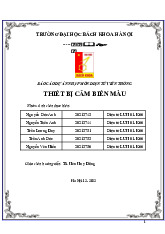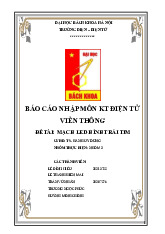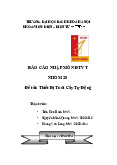



















Preview text:
lOMoAR cPSD| 59595715 lOMoAR cPSD| 59595715 lOMoAR cPSD| 59595715 lOMoAR cPSD| 59595715 lOMoAR cPSD| 59595715
Problem solving consists of using generic or ad hoc methods in an orderly manner to
find solutions to problems. Some of the problem-solving techniques developed and
used in philosophy, artificial intelligence, computer science, engineering,
mathematics, or medicine are related to mental problem-solving techniques studied in psychology.
Problem solving in psychology refers to the process of finding solutions to problems
encountered in life.[2] Solutions to these problems are usually situation or
contextspecific. The process starts with problem finding and problem shaping, where
the problem is discovered and simplified. The next step is to generate possible
solutions and evaluate them. Finally a solution is selected to be implemented and
verified. Problems have an end goal to be reached and how you get there depends
upon problem orientation (problem-solving coping style and skills) and systematic analysis.[3]
A mathematical problem is a problem that is amenable to being represented,
analyzed, and possibly solved, with the methods of mathematics. This can be a
realworld problem, such as computing the orbits of the planets in the solar system, or
a problem of a more abstract nature, such as Hilbert's problems. lOMoAR cPSD| 59595715 Step 1: define a problem
Collect and analyze the facts in relation to the original question in order to fully
discover and define the problem. You should be able to write a statement of the actual
problem to be solved. This statement may include the definition of variables, which
you plan to use to help solve the problem. Step 2: plant its treatment
Determine what values, principles, and basic practices are applicable to the problem.
Plan the method for dealing with the facts in light of these ways of approach. You should
be able to list the series of steps that need to be done in order to solve the problem Step 3: Execute the plan
Carry through the plan so as to reach a decision or result. Often the decision does not
end the problem but clarifies or changes the issue so that the problem is started over
in a new aspect. This step is often called “ turning the crank” to carry out the steps
outlined in the definition of the problem solving plan
Step 4 – Check the work as a whole before using the solution
Go over the results, first systematically then realistically in terms of use, and at last
with reference to the general knowledge and experience of that field. We wil define
two specific techniques for checking the mathematical work to make sure that no
errors are involved. You may want to solve the problem by an alternate method to
insure that it is correct. You should never wonder if your solution is correct. Your
checks will show you that it is correct.
Step 5: learn and generalize if possible
Take thought to find what can be learned that is of value in the situation at hand and
what can be learned that may be of use in future problem. Have you leanrned any new
tools that will be helpful in future problem. How has solving this problem expanded
you tool box of problem solving techniques?
https://en.wikipedia.org/wiki/Category:Problem_solving_skills lOMoAR cPSD| 59595715
Abstraction: solving the problem in a model of the system before applying it to the real system
Analogy: using a solution that solves an analogous problem
Brainstorming: (especially among groups of people) suggesting a large number of
solutions or ideas and combining and developing them until an optimum solution is found
Divide and conquer: breaking down a large, complex problem into smaller, solvable problems
Hypothesis testing: assuming a possible explanation to the problem and trying to
prove (or, in some contexts, disprove) the assumption Lateral
thinking: approaching solutions indirectly and creatively lOMoAR cPSD| 59595715
CHIẾN LƯỢC GIẢI QUYẾT VẤN ĐỀ Chiến lược Tóm tắt
Phân tích ường tới Chọn một hành ộng ở mỗi bước ể tiến gần hơn ến mục tiêu ích
Phương pháp của các Tổng hợp các ặc iểm dường như không khớp của các ối tượng ối tượng tiêu iểm
khác nhau thành một cái gì ó mới Phân tích hình thái
Đánh giá ầu ra và tương tác của toàn bộ hệ thống như một tổng thể Chứng minh
Cố gắng chứng minh rằng vấn ề không thể ược giải quyết. Điểm mà
chứng minh thất bại sẽ là iểm khởi ầu ể giải quyết vấn ề Rút gọn
Chuyển vấn ề thành vấn ề khác ể giải pháp tồn tại Nghiên cứu
Sử dụng các ý tưởng hiện có hoặc iều chỉnh các giải pháp hiện có cho các vấn ề
tương tự Phân tích nguyên Xác ịnh nguyên nhân của vấn ề nhân gốc rễ Thử và sai
Kiểm tra các giải pháp có thể cho ến khi tìm thấy úng 4/17/2020
VIỆN ĐIỆN TỬ VIỄN THÔNG, ĐẠI HỌC BÁCH KHOA HÀ NỘI, NGUYỄN ĐỨC MINH 9
Means-ends analysis: choosing an action at each step to move closer to the goal
Method of focal objects: synthesizing seemingly non-matching characteristics of
different objects into something new
Morphological analysis: assessing the output and interactions of an entire system
Proof: try to prove that the problem cannot be solved. The point where the proof fails
will be the starting point for solving it
Reduction: transforming the problem into another problem for which solutions exist
Research: employing existing ideas or adapting existing solutions to similar problems
Root cause analysis: identifying the cause of a problem
Trial-and-error: testing possible solutions until the right one is found lOMoAR cPSD| 59595715
Informal "real-world" mathematical problems are questions related to a concrete
setting, such as "Adam has five apples and gives John three. How many has he left?".
Such questions are usually more difficult to solve than regular mathematical exercises
like "5 − 3", even if one knows the mathematics required to solve the problem. Known
as word problems, they are used in mathematics education to teach students to
connect real-world situations to the abstract language of mathematics. In general, to
use mathematics for solving a real-world problem, the first step is to construct a
mathematical model of the problem. This involves abstraction from the details of the
problem, and the modeller has to be careful not to lose essential aspects in translating
the original problem into a mathematical one. After the problem has been solved in
the world of mathematics, the solution must be translated back into the context of the original problem.
By outward seeing, there is various phenomenon from simple to complex in the real
world. The some of that have also the complex mechanism with microscopic
observation whereas they have the simple outward look. It depend to the scale of the
observation and the stability of the mechanism. There is not only the case that simple
phenomenon explained by the simple model, but also the case that simple model
might be able to explain the complex phenomenon. One of example model is a model by the chaos theory. lOMoAR cPSD| 59595715
Abstraction: solving the problem in a model of the system before applying it to the real system
Analogy: using a solution that solves an analogous problem
Brainstorming: (especially among groups of people) suggesting a large number of
solutions or ideas and combining and developing them until an optimum solution is found
Divide and conquer: breaking down a large, complex problem into smaller, solvable problems
Hypothesis testing: assuming a possible explanation to the problem and trying to
prove (or, in some contexts, disprove) the assumption Lateral
thinking: approaching solutions indirectly and creatively
Means-ends analysis: choosing an action at each step to move closer to the goal
Method of focal objects: synthesizing seemingly non-matching characteristics of
different objects into something new
Morphological analysis: assessing the output and interactions of an entire system
Proof: try to prove that the problem cannot be solved. The point where the proof fails
will be the starting point for solving it
Reduction: transforming the problem into another problem for which solutions exist
Research: employing existing ideas or adapting existing solutions to similar problems lOMoAR cPSD| 59595715
Root cause analysis: identifying the cause of a problem
Trial-and-error: testing possible solutions until the right one is found
Downloaded by Taj Tjk (tajtjkadv86@gmail.com) 11
Abstraction: solving the problem in a model of the system before applying it to the real system
Analogy: using a solution that solves an analogous problem
Brainstorming: (especially among groups of people) suggesting a large number of solutions
or ideas and combining and developing them until an optimum solution is found
Divide and conquer: breaking down a large, complex problem into smaller, solvable problems
Hypothesis testing: assuming a possible explanation to the problem and trying to
prove (or, in some contexts, disprove) the assumption
Lateral thinking: approaching solutions indirectly and creatively
Means-ends analysis: choosing an action at each step to move closer to the goal Method
of focal objects: synthesizing seemingly non-matching characteristics of different objects into something new
Morphological analysis: assessing the output and interactions of an entire system Proof:
try to prove that the problem cannot be solved. The point where the proof fails will be
the starting point for solving it
Reduction: transforming the problem into another problem for which solutions exist
Research: employing existing ideas or adapting existing solutions to similar problems 12
Root cause analysis: identifying the cause of a problem
Trial-and-error: testing possible solutions until the right one is found
Eight Disciplines Problem Solving GROW model How to Solve It
OODA loop (observe, orient, decide, and act)
PDCA (plan–do–check–act) Root cause analysis
RPR problem diagnosis (rapid problem resolution)
TRIZ (in Russian: Teoriya Resheniya Izobretatelskikh Zadach, "theory of solving
inventor's problems") A3 problem solving
Eight disciplines problem solving(8Ds) is a method developed at Ford Motor Company
used to approach and to resolve problems, typically employed by engineers or other
professionals. Focused on product and process improvement, its purpose is to identify,
correct, and eliminate recurring problems.[1] It establishes a permanent corrective
action based on statistical analysis of the problem and on the origin of the problem by
determining the root causes. Although it originally comprised eight stages, or
'disciplines', it was later augmented by an initial planning stage. 8D follows the logic of
the PDCA cycle. The disciplines are:
D0: Preparation and Emergency Response Actions: Plan for solving the problem and
determine the prerequisites. Provide emergency response actions.
D1: Use a Team: Establish a team of people with product/process knowledge.
Teammates provide new perspectives and different ideas when it comes to problem solving.
D2: Describe the Problem: Specify the problem by identifying in quantifiable terms the
who, what, where, when, why, how, and how many (5W2H) for the problem. D3:
Develop Interim Containment Plan: Define and implement containment actions to
isolate the problem from any customer.
D4: Determine and Verify Root Causes and Escape Points: Identify all applicable causes
that could explain why the problem has occurred. Also identify why the lOMoAR cPSD| 59595715
problem was not noticed at the time it occurred. All causes shall be verified or proved.
One can use five whys or Ishikawa diagrams to map causes against the effect or problem identified.
D5: Verify Permanent Corrections (PCs) for Problem will resolve problem for the
customer: Using pre-production programs, quantitatively confirm that the selected
correction will resolve the problem. (Verify that the correction will actually solve the problem).
D6: Define and Implement Corrective Actions: Define and implement the best
corrective actions. Also, validate corrective actions with empirical evidence of improvement.
D7: Prevent Recurrence / System Problems: Modify the management systems,
operation systems, practices, and procedures to prevent recurrence of this and similar problems.
D8: Congratulate the Main Contributors to your Team: Recognize the collective efforts
of the team. The team needs to be formally thanked by the organization. lOMoAR cPSD| 59595715
G Goal The Goal is the end point, where the client wants to be. The goal has to be
defined in such a way that it is very clear to the client when they have achieved it. R
Reality The Current Reality is where the client is now. What are the issues, the
challenges, how far are they away from their goal?
O Obstacles There will be Obstacles stopping the client getting from where they are
now to where they want to go. If there were no Obstacles the client would already have reached their goal.
Options Once Obstacles have been identified, the client needs to find ways of dealing
with them if they are to make progress. These are the Options.
W Way Forward The Options then need to be converted into action steps which will
take the client to their goal. These are the Way Forward. lOMoAR cPSD| 59595715
First principle: Understand the problem
"Understand the problem" is often neglected as being obvious and is not even
mentioned in many mathematics classes. Yet students are often stymied in their
efforts to solve it, simply because they don't understand it fully, or even in part. In
order to remedy this oversight, Pólya taught teachers how to prompt each student
with appropriate questions,[7] depending on the situation, such as:
What are you asked to find or show?[8]
Can you restate the problem in your own words?
Can you think of a picture or a diagram that might help you understand the problem?
Is there enough information to enable you to find a solution?
Do you understand all the words used in stating the problem?
Do you need to ask a question to get the answer?
The teacher is to select the question with the appropriate level of difficulty for each
student to ascertain if each student understands at their own level, moving up or
down the list to prompt each student, until each one can respond with something constructive.
Second principle: Devise a plan
Pólya mentions that there are many reasonable ways to solve problems.[3] The skill at
choosing an appropriate strategy is best learned by solving many problems. You will




